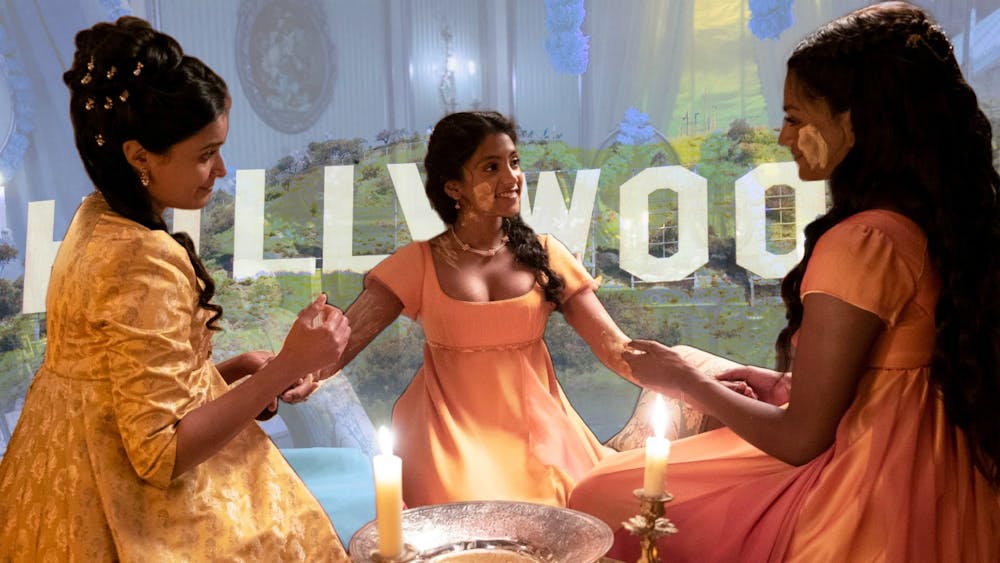After years of yielding to the stereotypical roles of Ravi from Jessie and Baljeet from Phineas and Ferb, the unstoppable Hollywood force who is Shonda Rhimes has provided South Asians—specifically South Asian women—with a breath of fresh air. Her casting choices for Netflix's Bridgerton Season 2 in selecting two dark skin Tamilian actresses for the show’s leads, paired with the subtlety of cultural hints throughout the show, is exactly what this community has been longing for. Simone Ashley’s Kate Sharma and Charithra Chandran’s Edwina Sharma are the Parvati and Padma Patil redemption that was so desperately needed after decades.
The central focus generated from this diverse cast is how the show’s sophomore season has deconstructed colorism and Eurocentric beauty standards. Throughout film and media, there’s been a tending towards casting lighter skin actors who are perceived as more desirable than darker skin counterparts. Evidently, South Asian women don’t get enough representation in Western media, but, shockingly enough, they’re oppressed in their own cultural media—Bollywood—as well, where the fetishization for actresses with lighter skin tones runs rampant. This culture propagates how skin–lightening products like Fair and Lovely, now called Glow and Lovely after years of criticism, have managed to remain popular. It’s a blatant exemplification of colorism, which both mentally and physically harms women.
This issue doesn’t exist just on–screen, though. Indian girls have been accosted for looking “too tan” after a summer season, or for just their natural skin color, too. Concurrently, the skin bleaching industry makes millions off this societal insecurity, which increases the risk of cancer and chemical burns for many. In opposition to that, it’s been delightful to see how the Sharma sisters have humanized those who have darker skin.
Besides battling the issue of colorism, something that struck a lot of the South Asian community was the slight Indian accent Ashley and Chandran incorporated into their dialogue. The actresses normalized the accent without exaggerating it, contrasting the stereotypical accents heard in Hollywood previously, which perpetuate a mocking and awkward perception of Indian people. The implications of the actresses’ pronunciations felt evocative of how two cultures can be simultaneously balanced and respected.
Bridgerton’s newest season isn't the first representation of South Asian women in Hollywood, though. Mindy Kaling should obviously ring a bell: She’s repeatedly broken the glass ceiling by spotlighting South Asian women as leads for multiple of her admired productions. And while the Indian–American comedian’s projects have been novel and historic, there are still some drawbacks to the representation that is perpetuated in her shows.
Kaling’s shows like The Mindy Project and Never Have I Ever, though amusing, sometimes see an overlap in plot—where a traditionally hot, white male character comes to the shocking revelation of finding the South Asian lead attractive. This type of South Asian representation comes off as problematic in the shows' ultra–white spheres when minority women characters have been perceived as too nerdy, too awkward, too ugly, or even too hairy or smelly. After years of being the butt of male comedian jokes—see Russell Peters—there was a pressure to uplift Kaling’s and other similar representations because, frankly, it was the only South Asian representation we really ever got, even though it was sometimes, understatedly, an object of derision.
Contrastingly, race wasn’t a factor at all in Kate and Anthony’s (or even Edwina and Anthony’s) relationship and the Sharma sisters were not perceived as any less attainable or beautiful. In fact, Edwina was named the “diamond of the season," transcending past these years of layered jokes of South Asian women being unappealing. I deeply appreciated how Anthony adored Kate's perfume, as it combated the prolonged jokes Indians have ensured about smelling like spices.
Aside from how this season has battled the past suppression of South Asian women and colorism in media, the unique details paying homage to the Sharmas' Indian heritage were particularly touching. From the cardamom in Kate’s tea to the hair oiling, and the Haldi ceremony to the marigold garlands and flowers in the Sharmas’ hair, we see practices that are regularly performed in Indian culture, carried out in English noble society. In addition to the inclusion of popular Hindi movie songs in the show’s musical score, Bridgerton emphasized the importance of integrating Indian customs through the costumes, as well. Designer Sophie Canale indicated how her team implemented jewel tones and traditional embroidery into the Indian textiles used to fashion the Sharmas’ ensemble, complemented with bangles and jhumkas, to deliver a signature Indian–influenced look.
And while Bridgerton is an English show, it was heartwarming to me—as a girl who speaks and understands a few Indian languages—to hear how the dialogue incorporated Indian words I recognize, like Amma and Appa, terms used to call one’s mother and father respectively in South India. I remember immediately texting my parents in awe when I heard words I’ve said myself in the show like “Bapre," a common word for showcasing shock, and “Bon," which refers to younger sisters in the Bengali language. Of course, “Didi” is a nationally–recognized word for calling one’s older sister.
These minute details of Bridgerton may not seem like much, but they’re truly a microcosm of how different cultures and identities can be balanced in not just media, but real life, too. As Charithra Chandran expresses herself, Bridgerton digs deep into illustrating a magical sense of representation while battling overarching societal issues like colorism. Seeing someone finally representing what your identity truly means to you, not tainted by insensitive, stereotypical jokes, is something that a lot of others who look like me have finally seen for the first time in Western media. This newly–tread realm of television is celebrating multiculturalism while dismantling discrimination, and I hope that this is just the start.







